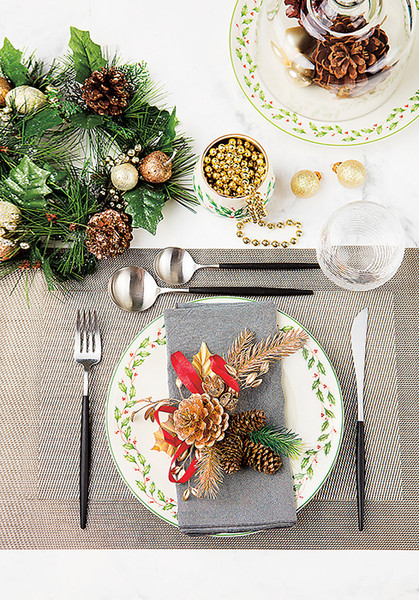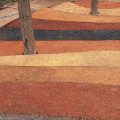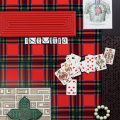What dishes most preferred for serving New Year's table
If we are talking about a home New Year's celebration,then the choice of tableware comes down to the possibilities of a particular home, and also takes into account the scale of the upcoming celebration. After all, each home has different possibilities and a different number of guests. Therefore, in one case it can be a large antique service, in another - a set of dishes of a modern design, and in a third - bright, New Year's decorated disposable tableware. We can celebrate the New Year both in a narrow family circle, and in a crowded company of our friends, relatives and colleagues somewhere in the country, in nature, outside the city. In a word, the tableware can be any, but with the help of a variety of table accessories and various serving items, the appearance of the festive table can be given the most spectacular and ceremonial look. Photo: iStock/Gettyimages.ru
Photo: iStock/Gettyimages.ru
How to arrange the plates on the table
The serving is primarily focused on the generalnumber of guests. A personal place setting, i.e. a set of dishes for one person, is called a couvert. Guests at the table should be seated in such a way that each place setting (couvert) is at least 60 cm long and 30 cm deep. In this case, the place setting for each guest can easily be served with a full set of dishes. At the same time, the guests sitting at the table will not be cramped - it is convenient not only to eat, but also to communicate with each other, which is very important for the New Year's holiday. The couvert is served as follows: a serving plate with a diameter of up to 32 cm is placed directly in front of the guest, on which a small dining (D 24 cm) and a snack (D 20 cm) plate are placed. The serving plate plays a decorative role, nothing is ever eaten from it. To the left of these plates is a bread (aka pie) plate (D 17.5 cm). It is intended for bread, pies and sandwiches. According to the rules, the center of the snack and bread plates should be located on the same line parallel to the edge of the table. An exception is made when setting a round table and for the end sides of a large rectangular table. With this arrangement, the bread plate is placed slightly higher on the left side of the tablecloth. The plates are laid out at a distance of approximately 1.5-2 cm from the edge of the table. If you place them closer to the edge of the table, the setting will look unattractive, and if further, it will be unsafe for guests (you can leave a stain on the tablecloth).
Where and how should the cutlery be placed
Forks are laid out to the left of the wildcardplates with the tines facing up. Appetizer forks, which are used first on the menu, are placed farthest to the left. Knives are laid out, on the contrary, to the right of the serving plate with the blade facing the plate. The appetizer knife is placed farthest to the right. As the dishes are changed, the utensils are used from the edge towards the center of the plate. If there is no menu, then the type of cutlery laid out can easily indicate what dishes will be served to the guests. Appetizers can be served in two pairs, if, for example, fish and meat appetizers are expected. After fish dishes, the utensils are always changed. The same applies to table knives and forks. If both fish and meat are served, then the fish knife and fork must be laid out, followed by the table knife and fork. Dessert utensils can be set out immediately, at the beginning of the feast, but can appear on the table after the table setting has been changed, before serving dessert. In the first case, they are laid out in the upper part of the cover above the serving plate, and in the second case, in the usual way.
What should be a festive tablecloth
The color of the tablecloth depends on the main colorsdishes, wine glasses and goblets. It is also necessary to take into account the colors and shades of the interior of the room where the festive feast will take place. Flowers, candles and other table decorations are selected to match the tablecloth. For the most formal events, a white tablecloth, candles and dishes are usually used. But brighter and even contrasting colors are also suitable for a New Year's holiday. The tablecloth should not be too small for the table. The table will look short. At the edges, the tablecloth should hang from the table by at least 25 cm. The longer the tablecloth, the richer and more impressive the table looks. A table napkin on a tablecloth in the same tone or a contrasting shade can serve as a good addition to the table decoration.
Is it permissible to use paper napkins in the setting of the festive table
Yes, it is possible.But we must understand: the greater our desire to impress our guests, the more solemn and richly the New Year's table is set, the higher quality and more expensive all the accessories and table setting items should be. Including table napkins. With such high requirements for table setting, paper napkins are no longer used.
Are there any differences in how the table is laid for a home reception with a large number of guests and for a romantic New Year's Eve together
Of course.These are two different, as they say, formats of the holiday. At large receptions, all the rules of table setting are usually strictly observed. Such a requirement for the appearance of the table is associated not only with the necessary comfort at receptions with seating, but also with aesthetic requirements. A large, beautifully set table looks elegant and harmonious. For romantic meetings, the rules are not so strict. In the narrowest circle, the personal tastes and preferences of the couple dominate, with their ideas about beauty, harmony and love.
How to use cutlery
The fork is held in the left hand, the knife in the right hand.The handles of the cutlery are placed in the palms. The index finger of the left hand should not rest on the bend of the fork tines, but only on its base. The index finger of the right hand should not rest on the blunt side of the knife blade. It is also placed at the base of the blade. During the meal, only the hands move. The cutlery should not knock on the plate. Eating and chewing (with a closed mouth, of course) should be done silently. Cutlery must be placed on a plate or on the table with an emphasis on the plate if there is a desire to drink wine or water. It is not customary to hold a glass of drinks and a fork in your hands at the same time.
How to cope with the main dishes of the holiday table
It is hardly possible to learn the basic rulestable etiquette in a magazine article, but I can still give some practical advice to your readers. In order to enjoy a festive feast, first of all, we must learn or at least strive to eat aesthetically, beautifully. To begin with, it is necessary to observe the sequence in eating dishes. For example, you cannot eat herring, and then stellate sturgeon or sturgeon. It will seem tasteless. It is correct to first eat lightly salted fish, and then heavily salted fish. It is customary to eat meat after fish dishes, and not vice versa. Meat is cut off piece by piece, and not the whole piece at once. Sauce is poured on a piece of fish or meat, and not poured on a side dish. Bread is not bitten off from a piece, but broken off piece by piece and put in the mouth. If we want to make a sandwich with butter and caviar, we do not spread butter on the bread while it is hanging, but put it on our bread plate. Cognac is drunk at the end of the feast and is not eaten with lemon. Cognacs and brandy are best combined with orange (ideally kumquat), and not with lemon. It is not customary to cut whole fish with a knife. It is eaten with a fish knife and fork in such a way that the fish skeleton and rib bones remain intact. In this form, the dish will look more aesthetically pleasing. Fruits for the dessert table should be safe and easy to eat. For this reason, it is not customary to serve, for example, pomegranates or grapes with seeds at the festive table.









